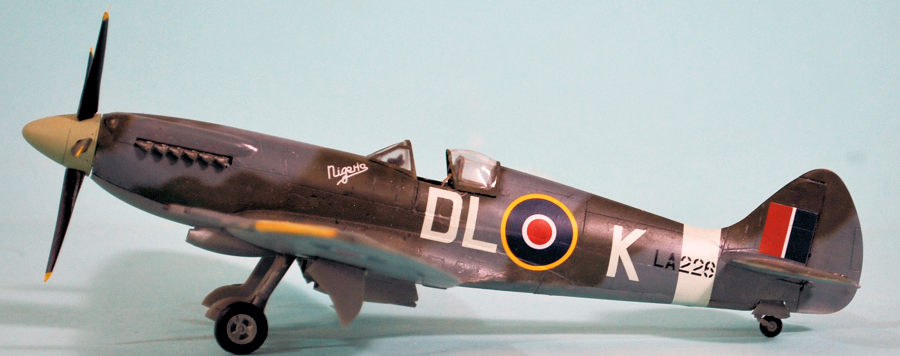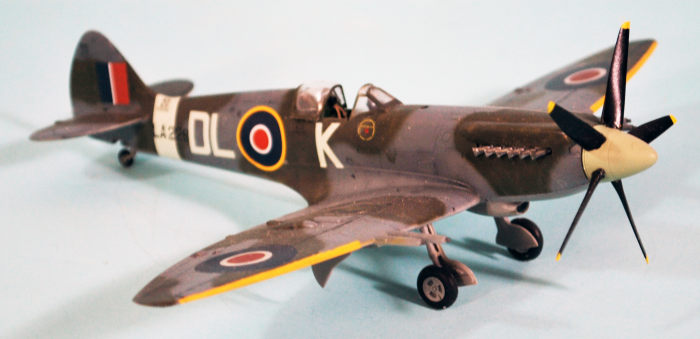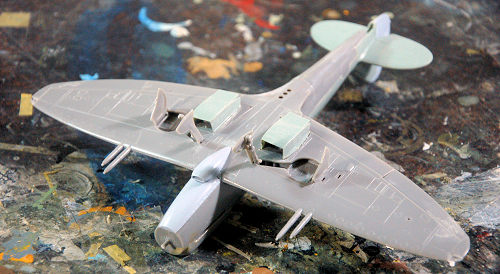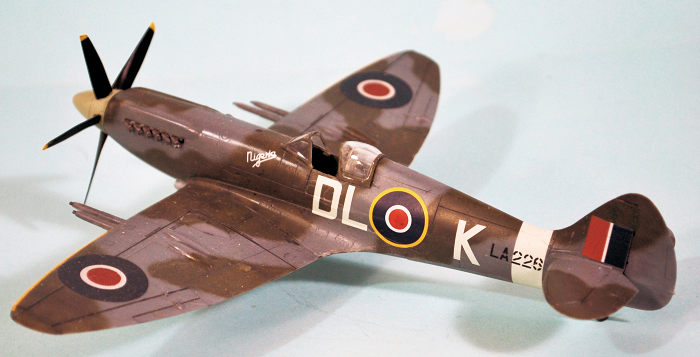
Academy/Airfix 1/48 Spitfire 21
| KIT #: | |
| PRICE: | |
| DECALS: | |
| REVIEWER: | Tom Cleaver |
| NOTES: |
|

| HISTORY |
The Spitfire 21 was so different from all the Spitfires that came before that it was originally thought it should be named the “Victor.” In the end, the Spitfire name was retained.
 Based
on the experimental Spitfire Mk.IV/XX, the Spitfire 21 (Supermarine Type 356)
featured a new semi-elliptical wing that was considerably strengthened from the
standard Spitfire wing, to take an armament of 4 20mm cannon. The landing gear
was repositioned and fully enclosed. The aircraft was fitted with a propeller of
increased diameter from the Spitfire XIV and XVIII, and had a normal loaded
weight of 9.900 pounds with a maximum overload of 11,200 pounds – a far cry from
the fully-loaded weight of 6,200 pounds for the Spitfire I! Maximum speed at
19,000 feet was 450 mph, with a climb of 4,900 fpm, which was better than the
Meteor III jet fighter. Though 3,000 Spitfire 21s were originally ordered, in
the end only 120 were delivered due to the war ending. The first was delivered
on September 6, 1944, with the last of the 120 delivered January 2, 1946.
Based
on the experimental Spitfire Mk.IV/XX, the Spitfire 21 (Supermarine Type 356)
featured a new semi-elliptical wing that was considerably strengthened from the
standard Spitfire wing, to take an armament of 4 20mm cannon. The landing gear
was repositioned and fully enclosed. The aircraft was fitted with a propeller of
increased diameter from the Spitfire XIV and XVIII, and had a normal loaded
weight of 9.900 pounds with a maximum overload of 11,200 pounds – a far cry from
the fully-loaded weight of 6,200 pounds for the Spitfire I! Maximum speed at
19,000 feet was 450 mph, with a climb of 4,900 fpm, which was better than the
Meteor III jet fighter. Though 3,000 Spitfire 21s were originally ordered, in
the end only 120 were delivered due to the war ending. The first was delivered
on September 6, 1944, with the last of the 120 delivered January 2, 1946.
The Spitfire 21 achieved operational status with 91 Squadron in April 1945, with a few patrols carried out over Holland. The only Spitfire 21 victory was a Heinkel He-162 from JG 1 on April 28, 1945, the only Volksjaeger lost in air combat. The Spitfire 21 served in the Auxiliary Air Force after the war, leaving service in 1949.
| THE KITS |
Aeroclub released a limited-run Spitfire XIV fuselage which
could be mated to the Airfix Spitfire 22/24 kit to do a Spitfire 21. With the
demise of Aeroclub, that is no longer available.
Planet Models released a relatively expensive Spitfire 21 resin kit, which is really just resin castings based on the (oversize) Academy Spitfire XIV fuselage mated to Spitfire 22/24 wings.
| CONSTRUCTION |
 This
model is a “waste not/want not” project created from left-over parts from
previous projects. I had a Spitfire 22 fuselage and a Seafire 45 wing left over
from other projects, and no need of the Academy Spitfire XIV now that the
superior Airfix kit is available.
This
model is a “waste not/want not” project created from left-over parts from
previous projects. I had a Spitfire 22 fuselage and a Seafire 45 wing left over
from other projects, and no need of the Academy Spitfire XIV now that the
superior Airfix kit is available.
Basically, this is the Spitfire 22/24 fuselage from the cockpit forward
and the lower fuselage half below the centerline back to the tail unit, mated to
the Academy upper rear fuselage and vertical fin/rear fuselage. Doing this, I
discovered that the Academy fuselage is actually 3/32 inch too deep, compared
with the correct
 Airfix
kit. I had to take out a section of the Academy rear fuselage area just beneath
the horizontal stabilizers to keep the lower fuselage line. I used a left-over
narrow-chord Airfix Spitfire XIV rudder. The Academy radiators were used,
despite not being “right” but being “available.” I kept the cockpit flap up
since the cockpit interior was pieced together from spare parts and didn’t need
to be closely examined by any viewers.
Airfix
kit. I had to take out a section of the Academy rear fuselage area just beneath
the horizontal stabilizers to keep the lower fuselage line. I used a left-over
narrow-chord Airfix Spitfire XIV rudder. The Academy radiators were used,
despite not being “right” but being “available.” I kept the cockpit flap up
since the cockpit interior was pieced together from spare parts and didn’t need
to be closely examined by any viewers.
I broke down and bought the very nice Barracuda Studios resin 5-blade prop, which is the correct diameter for the Spitfire 21, and used the later windscreen and “bubble” hood that was extra in the Eduard Spitfire I kit.
| COLORS & MARKINGS |
 I
painted the model with Tamiya RAF Dark Green XF-81, Ocean Grey XF-82 and Sea
Grey Medium XF-83, using the Spitfire 21 profile in the ancient Harleyford
“Spitfire: The Story of a Famous Fighter.”
I
painted the model with Tamiya RAF Dark Green XF-81, Ocean Grey XF-82 and Sea
Grey Medium XF-83, using the Spitfire 21 profile in the ancient Harleyford
“Spitfire: The Story of a Famous Fighter.”
I used the good Airfix kit decals from a new-release Seafire 46/47 for the upper and lower wing roundels and fin flash, and the leftover decals from an Airfix Spitfire XII kit to do an airplane from 41 Squadron, with the serial number pieced together from letters and numbers on other sheets in the decal dungeon.
I attached the landing gear and the resin prop, and fitted the canopy in the open position.
| CONCLUSIONS |
Fifty years ago, kit-bashing like this was de rigeur for any “serious” modeler to get a final model that was anywhere close to outline accurate, given the kits that were available back then. It’s “old school modeling,” and fun to dust off the skills and discover it really is “like riding a bicycle.” A bunch of left-over parts didn’t go to the landfill.
3 December 2020
Copyright ModelingMadness.com
Review Kit courtesy of my spares box.
If you would like your product reviewed fairly and fairly quickly, please contact the editor or see other details in the Note to Contributors.
Back to the Main Page Back to the Review Index Page Back to the Previews Index Page